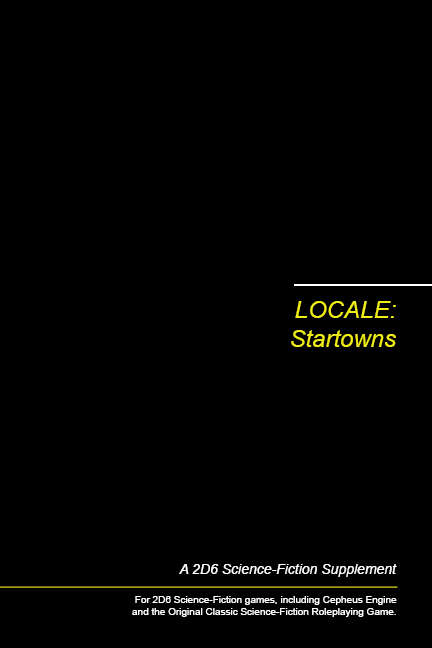LOCALE: Startowns
This article originally appeared in the July/August 2024 issue.

LOCALE: Startowns. Michael Brown.
Independently published
18pp., PDF
US$5.00/UK£3.93
Let’s face it, most of the interesting stuff in Traveller adventures doesn’t happen in jumpspace; more often than not, it happens “dirtside”.
Normally, it seems we just assume a ‘typical’ establishment of whatever type and quality is needed to advance the plot, without really considering whether such an establishment would actually exist, or whether doing business there might or might not lead to complications.
Enter this folio. Mr Brown briefly discusses the historical antecedents of the startown, and notes that even though the startown is technically under planetary jurisdiction, what is acceptable (or unacceptable) within its precincts may differ from what is acceptable (or unacceptable) elsewhere.
One may, of course, fiat that the startown is actually within the extraterritorial cession to the interstellar polity, and thus not subject to planetary law – but it is then subject to whatever rules the referee feels are appropriate for the Starport Authority or equivalent agency – and as it’s likely that the personnel manning the starport and any ancillary services (such as governance and policing the startown) will be drawn from the planetary population to the extent possible, some planetary attitudes might well ‘leak over’ anyway, regardless of what the ‘book’ says.
The ‘meat’ of this folio is a set of rules for developing the ‘strip’ – for all intents and purposes, the central business district – of a startown, taking into account the planetary law level (and modifying it to represent such ideas as either leniency to encourage trade or stricter enforcement because ‘foreigners who will corrupt our people’). By developing the startown ‘strip’, one can provide opportunities for various random events and finding rumors, or even just providing local color while the characters are wandering around, perhaps looking for opportunities.
The rules provided accommodate situations that aren’t quite ‘on the up-and-up’. The basic rules for generating locations provides the ‘legal’ version of an establishment (e.g., banks, hotels, bars); there are rules for ‘debauchery’, under which any establishment may have a ‘back room’ where the less lawful version of the business may operate (e.g., loan sharks, brothels, drug dens). Of course, if the effective law level in startown is low enough, the ‘debauched’ versions of the business may be operating openly…
There are actually two sets of rules for generating ‘the strip’; one is suitable for large and busy starports, and generates what amounts to ‘go down main street; on the left side as you’re walking, there’s the bank, AstroBurger, The Lodge, Matilda’s Boutique, …’. The other is suitable for detailing a section of the main drag of a large port, or for the entire main drag of a smaller port (perhaps a class D or E). The latter lets you define the outline and size of each establishment, including whether it’s multiple stories.
Mr Brown notes that a startown is in reality more than ‘the strip’, and suggests that referees who want to detail other areas of the startown look to his LOCALE: Cities.
Overall, I’d rate this folio as ‘useful’, and something that should generally be in the referee’s toolkit. Rather than purchasing it as a standalone product, however, it might be better to pick it up as part of one of Mr Brown’s package deals.
 Freelance
Traveller
Freelance
Traveller